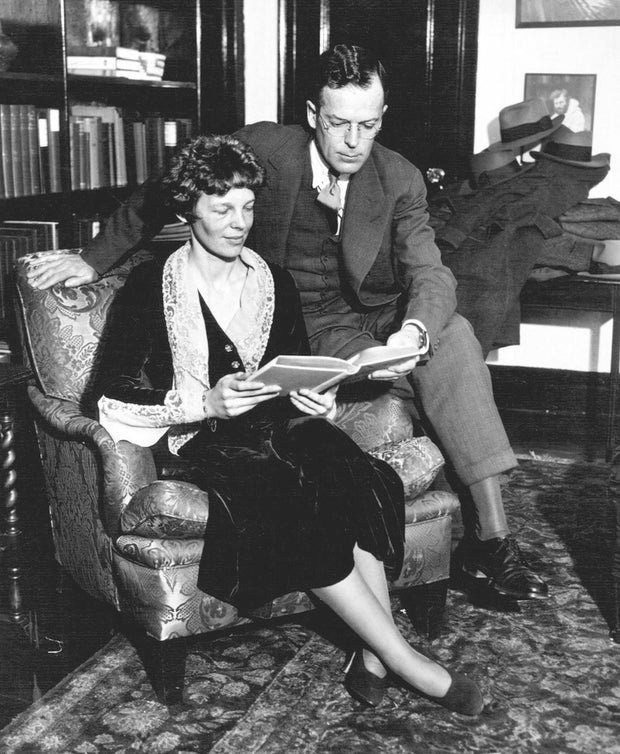
We may receive an affiliate commission from anything you buy from this article.
Everybody knows about Amelia Earhart’s mysterious final flight. But what about the years before she disappeared?
In “The Aviator and the Showman” (to be published July 15 by Viking), documentary filmmaker and journalist Laurie Gwen Shapiro draws on newly-uncovered sources to explore the famed pilot’s life and her marriage to wealthy publisher George Putnam. Theirs was a relationship that lifted love, publicity and especially risk to mythic heights.
Read an excerpt below.
“The Aviator and the Showman” by Laurie Gwen Shapiro
Prefer to listen? Audible has a 30-day free trial available right now.
Amelia Earhart was sitting across from George Palmer Putnam. He was on the phone, not acknowledging her, taking his sweet time. He was a flamboyant, career-making publisher who liked to be in the news. Putnam was always photographed with famous people: standing next to Charles Lindbergh, first man to fly solo across the Atlantic; posing with Commander Byrd, the man who conquered the South Pole; smiling with Howard Carter, the man who discovered King Tut. Amelia was thirty-one years old, a Boston social worker. She was not a famous person. But unknown to her that spring of 1928, Putnam had decided he wanted to create a new hero—the first woman to cross the Atlantic in an airplane!—the counterpart to the world’s most famous man, Charles Lindbergh.
Putnam sent out feelers to find candidates for such a heroine, who merely had to be the first female Atlantic passenger to get famous. The idea was familiar: sponsor the wildly risky adventure, find someone physically attractive and willing to imperil their own life, sign them to an exclusive tell-all deal, publicize the thing to the max, and make a fortune on book sales. Soon word came from Boston: George Putnam’s old friend, a PR guy named Colonel Hilton Howell Railey, had found a perfect candidate: Miss Earhart was an experienced flier, she was well spoken, and she had pleasing looks. George’s response was swift and decisive: “She must be in my office by the start of the next morning!” When George Palmer Putnam wanted things done, there was no room for argument. Railey told Amelia that someone in New York City wanted to see her about a possible flying venture. She was a committed full-time social worker and only a part-time aviator, but Amelia’s heart beat faster at the prospect of sponsored flying, a rarity for any woman, even the most accomplished pilot. She agreed to go to New York. Railey escorted her down from Boston by train. At 2 West Forty-Fifth Street, just off Fifth Avenue, a colossal Putnam banner fluttered from the rooftop. A landmark of New York’s Jazz Age publishing district, the Putnam Building reached sixteen stories skyward. An elegant retail bookstore graced its lobby, and its prime location was often touted in newspapers as “just 100 feet off Fifth.” Times Square, now ablaze with neon, was just a couple blocks west and had recently eclipsed Herald Square as the energetic heart of Manhattan.
On the day of Amelia’s arrival, thirty skyscrapers had already reshaped the Midtown skyline, transforming the area into a bustling hub aglow with neon lights. The district housed titans like The New York Times, the city’s most respected newspaper, and The New Yorker, a sharp-witted rising star on the media scene that, even in 1928, held outsize influence among the cultural elite. Railey brought Amelia to the elegant reception room of G. P. Putnam’s Sons and introduced her to George’s neat and professional brunette secretary, Miss Josephine “Jo” Berger. Dressed in the day’s standard attire for working women in publishing—back-seamed stockings and practical T-strapped low heels—Jo exuded an air of efficiency, and in her respectable brown day dress, with a powdered nose and a touch of rouge, Amelia, too, seamlessly blended into the office’s urbane ambiance.
Unbeknownst to her at that moment, Amelia Earhart was poised to become his next great triumph. George, the peacock at the handsome desk, was still conducting his power phone call, his deep voice filling the office. Impeccably dressed in a flawless double-breasted suit, he was well versed in commanding the room—and absorbing the admiring glances that often followed. To kill more minutes, Amelia’s eyes might have scanned what the bookcase held: there was Lindbergh’s famous G. P. Putnam’s Sons book, “WE” (those peculiar quotes around all caps), probably signed by the fabled Lindbergh himself. Should she confess to having a clipped newspaper picture of Lindbergh tacked up in her social worker’s bedroom? Would that be seen as genuine admiration or as an overly starry-eyed gesture for a woman her age?
At last, the publisher ended his call, allowing dramatic silence before inquiring, “And how about you? Do you consider yourself a risk-taker?” Amelia replied, “It depends. I’m here to learn more.” Weighing how much to disclose, and after securing her promise of secrecy, he shared glimpses of the confidential project: he was scouting for a female passenger to be the first across the Atlantic.
Years later, when Amelia’s name rang louder than even George’s, Railey candidly admitted—off the record—that he had been in that very room the day the very married George Palmer Putnam met Amelia Earhart. Thinking back to that significant meeting, Railey would muse all those years later: For George, it was undeniably “love at first sight.”
From “The Aviator and the Showman,” published by Viking, an imprint of Penguin Publishing Group, a division of Penguin Random House, LLC. Copyright © 2025 by Laurie Gwen Shapiro.
Get the book here:
“The Aviator and the Showman” by Laurie Gwen Shapiro
Buy locally from Bookshop.org
For more info: